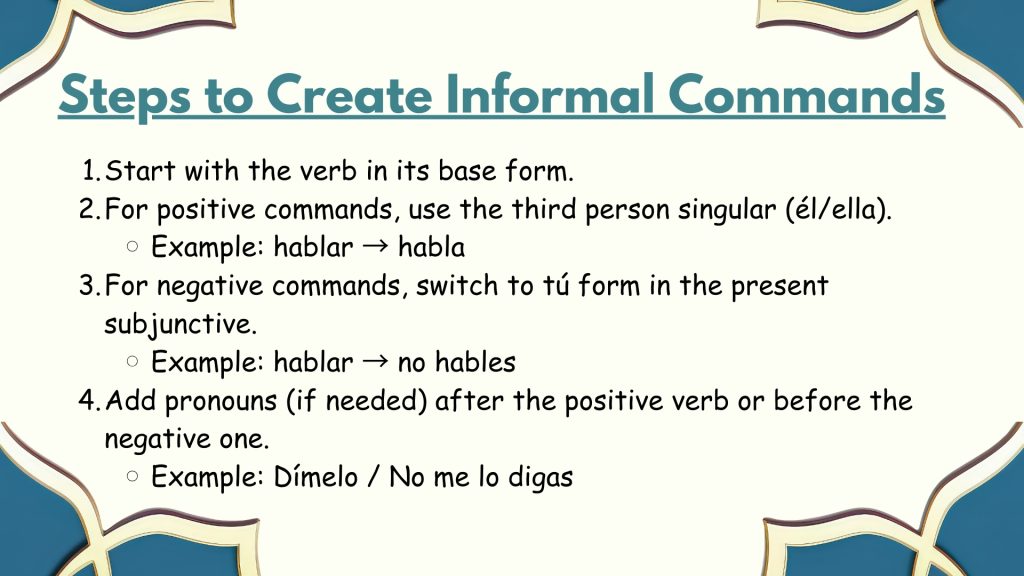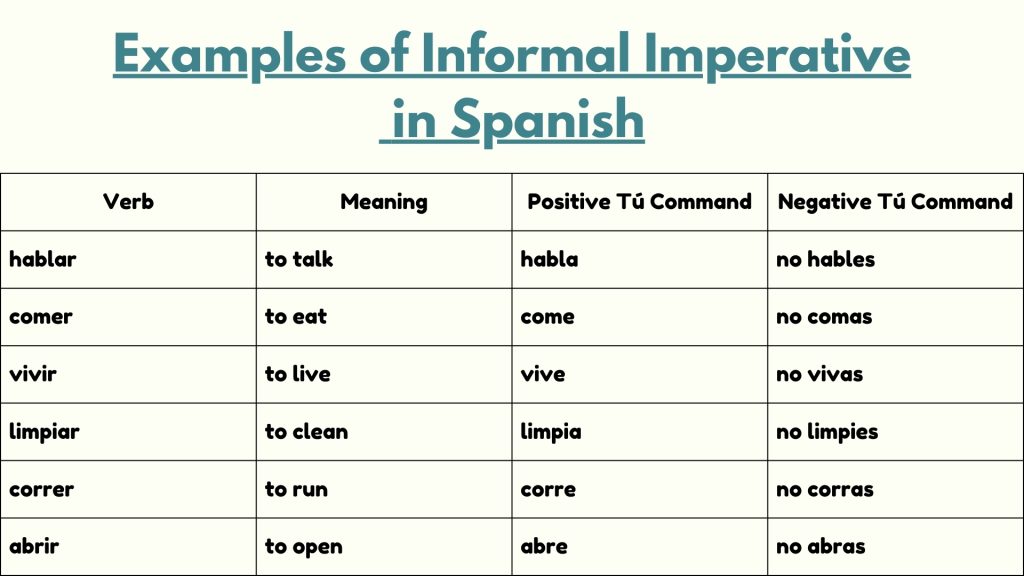The informal imperative in Spanish is really handy. It lets you give commands or advice when you’re talking to friends or family. Each type of verb, like -ar, -er, and -ir, changes a bit to fit casual chats.
It’s not just about knowing the rules of grammar. You also need to get the cultural vibe to avoid coming off as rude. Getting this right can really up your game in casual conversations. It makes you think about how language mixes with everyday life, doesn’t it?
What is an informal command in Spanish?
An informal command in Spanish, or ‘imperativo informal,’ is how you tell friends or family what to do.

It’s like giving a casual order or advice to someone you’re close with.
It’s just for people you know well.
| Spanish Term | English Meaning | Use Example |
|---|---|---|
| Camina | Walk | Camina conmigo al parque |
| Come | Eat | Come tus verduras |
| Escribe | Write | Escribe tu nombre aquí |
| Mira | Look | Mira este dibujo |
| Juega | Play | Juega con tu hermana |
Level up your Spanish vocabulary with these cheerful and meaningful ways to say congratulations.
How to form the imperative for commands in Spanish
Learning the informal imperative in Spanish means mastering how to give commands. This involves specific verb endings for each type of verb: -ar, -er, -ir.
You’ll need to remember these endings to make sure you’re clear in what you’re asking or telling someone to do. It’s all about being direct, whether you’re ordering, requesting, or inviting.
| Verb Type | Positive Tú Form | Negative Tú Form |
|---|---|---|
| -ar (e.g. hablar) | habla | no hables |
| -er (e.g. comer) | come | no comas |
| -ir (e.g. vivir) | vive | no vivas |
| Irregular (e.g. hacer) | haz | no hagas |
| Irregular (e.g. ir) | ve | no vayas |
How do you make an informal command in Spanish?
To make an informal command in Spanish, you’ll need to adjust the verb ending.

Steps to Create Informal Commands
- Start with the verb in its base form.
- For positive commands, use the third person singular (él/ella).
- Example: hablar → habla
- For negative commands, switch to tú form in the present subjunctive.
- Example: hablar → no hables
- Add pronouns (if needed) after the positive verb or before the negative one.
- Example: Dímelo / No me lo digas
Want to expand your Spanish vocabulary fast? Spanish Words That Start With H.
When to use informal commands in Spanish?
We’ve talked about how to make informal commands in Spanish. Now, let’s dive into when it’s right to use them.

Just remember, they’re not great for formal or professional spots. They can seem a bit disrespectful or too casual there.
| Situation | Example Command | Translation |
|---|---|---|
| Talking to a sibling | Limpia tu cuarto | Clean your room |
| Chatting with a friend | Ven aquí | Come here |
| Giving quick advice | Ten cuidado | Be careful |
| Encouraging someone | Sigue adelante | Keep going |
| Teaching a child | Dibuja un gato | Draw a cat |
Conclusion
The informal imperative in Spanish is all about giving commands or advice when you’re just hanging out or talking casually.
It uses special verb forms so you can be clear and direct when you’re speaking to friends or people you’re close with.
Getting good at this helps you communicate better in everyday situations, making sure you’re clear and on point when you need to give instructions or tips.
So, it’s pretty important to know how to use it right if you want to speak Spanish well in a laid-back setting.
Want to speak like a pro? Let Lingua Viva guide you.
Dayron is co-owner, and the heart of Lingua Viva. He is a licensed Educator and Interpreter with 15+ years of experience, and holds a graduate degree in Foreign Language Instruction. A native Caleño who creates a comfortable environment for his students. Dayron is loved by all and inspires confidence in his students when learning and speaking Spanish. He is also an avid comedian that loves to dance salsa.











